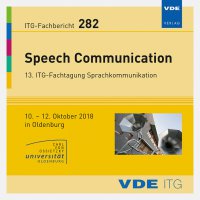The Occlusion Effect - Measurements, Simulations and Countermeasures
Conference: Speech Communication - 13. ITG-Fachtagung Sprachkommunikation
10/10/2018 - 10/12/2018 at Oldenburg, Deutschland
Proceedings: Speech Communication
Pages: 5Language: englishTyp: PDF
Personal VDE Members are entitled to a 10% discount on this title
Authors:
Zurbruegg, Thomas (toz GmbH, Frauenfeld, Switzerland)
Abstract:
Any object obstructing a human ear canal alters the perception of the speaker’s own voice. This phenomenon is denoted “Occlusion Effect” (OE) and is objectively quantified by the sound pressure in the occluded ear canal relative to the sound pressure in the open ear canal. Subjectively, it leads to a “boomy” or “echoing” perception of the own voice which is often described as “like talking into a barrel” and has led to the term “the hollow voice effect”. Traditional countermeasures include large vent bores (or even open fittings) and deep fittings, both approaches involving inherent trade-offs. A more recent approach employs active noise control (ANC) with the goal of canceling unwanted own voice sound portions by means of destructive interference.


